by David Walker, UK
The scales of 'Podura' (Collembola, springtail) are one of the earliest subjects reported as a test subject for the microscope (1828*) and aspects of the extensive history of its use and study are presented in an earlier article. Prepared slides can crop up regularly and unless an unusual example, they typically sell for modest sums. My fascination with this test subject started by owning one slide, but has prompted purchase of more examples. Presented below are the slides collected to date and include notes on how these examples reflect aspects of the history of the test subject.
*Nelson (17) notes that it was by Wollaston in a paper read in 1828 and published 1829 (18). Gill also published in 1828 his studies of scales supplied by Thomas Carpenter, who is regarded as the likely discoverer of their value as a test (19).
Three slides of the test species showing incorrect labeling
The scales of the test species of springtail are often wrongly labelled in some respect on the slide. Three examples are shown below; all are dry mounts.
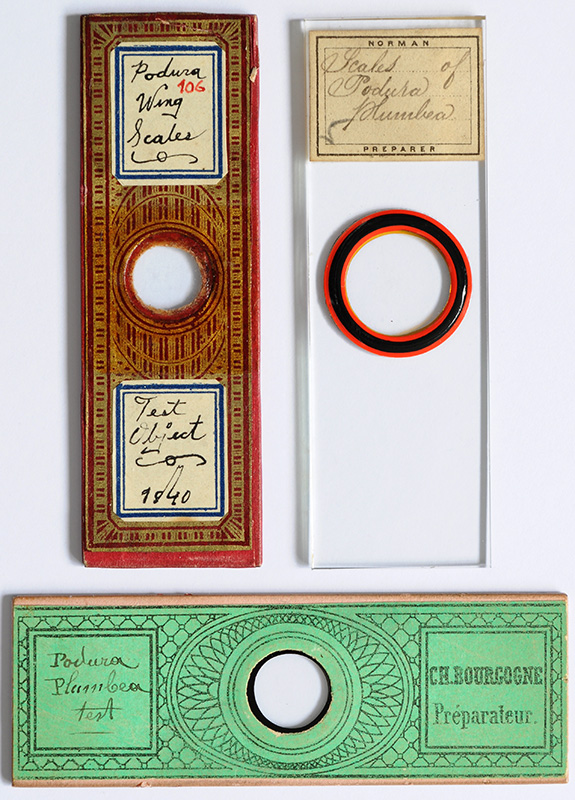
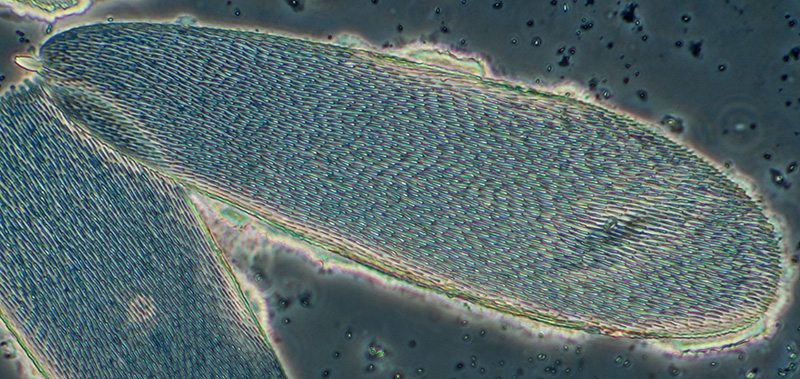
A typical scale of the test species of 'Podura' (Lepidocyrtus curvicollis). This example from the 1840 slide where the scales are particularly large. Scale length 185 um. Zeiss 40x NA0.75 objective, phase, white point focus. There are many papers discussing how the fine structure appeared using different lighting conditions under the optical microscope but the scales' ultrastructure wasn't confirmed until TEM studies in the 1960s (see earlier article).
Notes on the above slides:
Slide dated 1840 'Podura wing scales': Podura is currently a genus of Collembola, but was previously a higher taxonomic group (14); where not identified to species, 'Podura' is a correct label at the date this slide was made. 'Wing scales' is incorrect because springtails are wingless; depending on the species the scales can be on various parts of the body (15). Slides dated this early are uncommon and if dated correctly, this is only one year after the accepted wide introduction of the 3 x 1 inch slide as standard (2a). A similar pattern of gold tooled red papering is shown by Bracegirdle (2b).
Slides labelled 'Podura plumbea'. This is a common labeling often with 'Test' and examples by the 19th century makers Norman (British) and Charles Bourgogne (French) are shown. To assess whether these slide labels are correct, the scales need to be studied under the microscope. The scales of Podura plumbea Linn. and the classic test species Lepidocyrtus curvicollis Bourlet are very different as shown below and easily distinguished with modest microscope optics. The few slide examples which I possess labelled Podura plumbea all show the scales from the test species L. curvicollis. I would be very interested to hear from readers who have slides labelled 'Podura plumbea' which actually show this species. 'Podura plumbea' was later assigned Tomocerus plumbeus and examples of this slide have been seen at auction but don't possess any to determine what species' scales are shown.
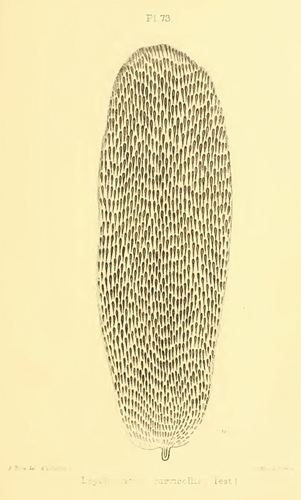
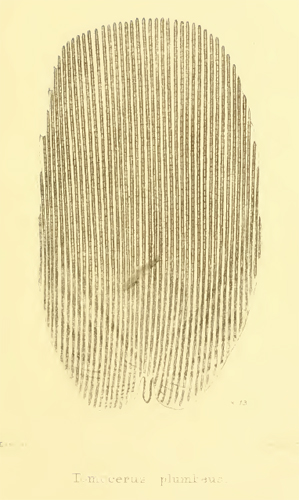
Plates 73 and 68 from Joseph Beck's Appendix (13b) to Lubbock's monograph (13) showing the test scale of Lepidocyrtus curvicollis (left) and 'Podura teres plumbea Linn.' ('Tomocerus plumbeus, Linn' in Lubbock's 1873 Monograph). The scales are very different and readily distinguished with low to medium power microscope objectives.
Norman is a well known maker and discussed in this excellent Micscape article by Brian Stevenson. Charles Bourgogne was a member of the Bourgogne family of prepared microscope slide makers; another member Joseph and wider aspects of the family are discussed in this Micscape article also by Brian. Also see entries for Norman and Bourgogne in Bracegirdle's book 'Microscopical Mounts and Mounters' (1). The Norman Podura slide uses thick glass and the slide is warped, preventing more critical studies of the scales.
Some likely contributing factors as to why the correct test species was often collected but described as Podura plumbea were briefly noted in the earlier article (see section 'Notes on Nomenclature'). Frans Janssens, Dept. of Biology, University of Antwerp and co-editor of the www.collembola.org website has reviewed the earlier literature on the 'Podura' test scales to assess the potential causes of the 'naming confusion' from a modern taxonomic standpoint. These findings are being published (in preparation) on the 'Collembola' website (20).
Whole mount of Podura with a strew of its scales
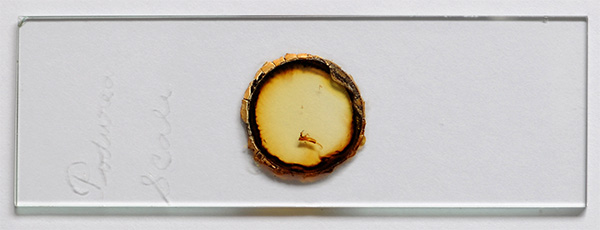
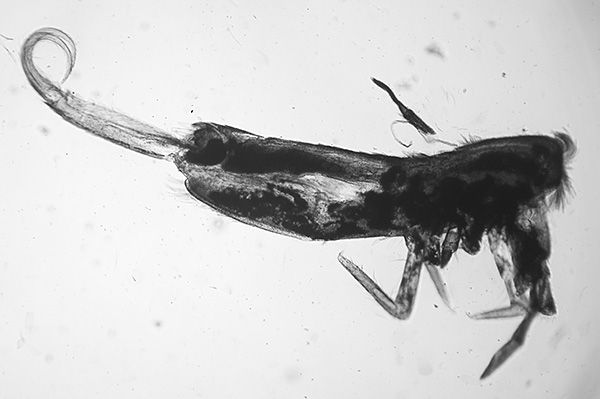
Whole mount. It is not presented flat. Zeiss 2.5x objective. Two limbs are broken off and out of field of view.
Body length - 2.4 mm, total length - 3.4 mm.
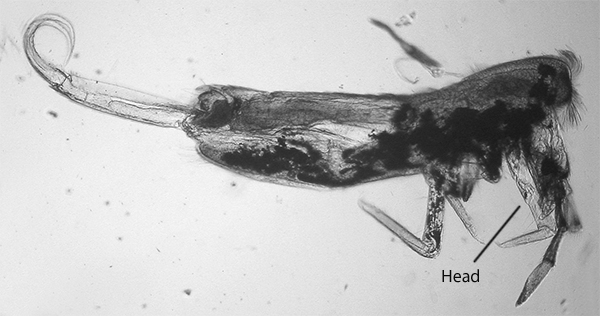
Whole mount in near infrared lighting using same objective, reveals body internal structure a little better. (Hoya R72 filter on microscope lamp field iris using home modified Sony S75 consumer digicam with sensor's near IR filter replaced with clear optical glass flat.)
The 'Second thoracic segment prominent, strongly overhanging the head' (quote from Hopkin, ref. 15, p.111) is a diagnostic feature of L. curvicollis..
This is the only slide I have seen to date showing both the whole podura specimen and a strew of its scales. It has a label in diamond writing 'Podurea scale' (sic). Its date is uncertain but possibly second half of 19th century. The specimen is not well cleared or mounted with some limbs broken off but does permit most key features to be seen for identification to species (shown below, all images with Zeiss 16x objective, DIC). I am a beginner at springtail ID and the likely genus is noted to be a difficult one, but believe from using Hopkin (15) and Fjellberg (16) that it is in the genus Lepidocyrtus and is the classic test species L. curvicollis. (Thank you to Frans Janssens, who has confirmed this from images shown, ref. 14).
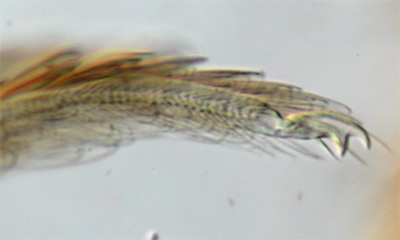
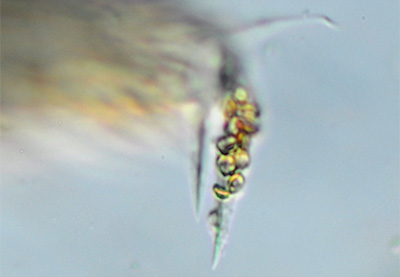
Left - tip of mucro showing two teeth (the tip of the extended posterior), right - tip of third leg.
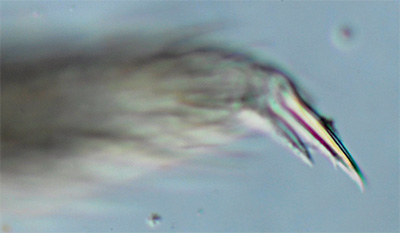
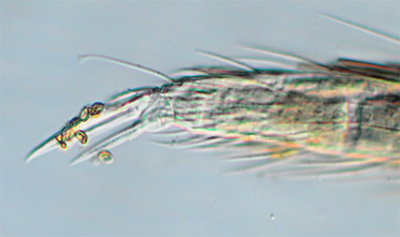
Left - tip of middle leg, right - tip of first leg.
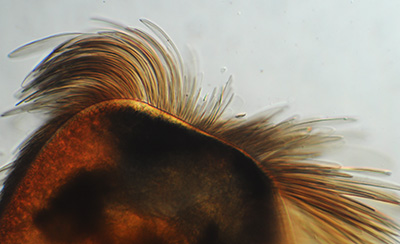
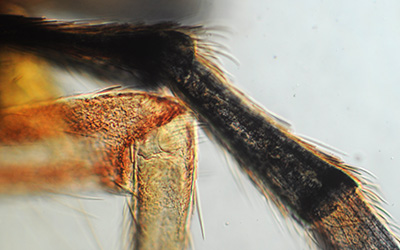
Left - head detail showing hairs and/or scales? Right - Base of antenna showing scales.
Showing a species whole mount with a strew of its scales is potentially of value, but this example demonstrates why the combination for microscopic study is only partly successful. The specimen is likely mounted in Canada balsam but this is detrimental for two reasons: 1) The inclusion of the whole mount makes the mountant layer thicker than it should be for scale strews alone, many scales don't touch the coverslip which can be detrimental for studying fine structure; 2) podura scales are usually mounted dry in air to maximise contrast and to ensure at least some touch the underside of the coverslip. The result is that it is difficult to view the scales' fine structure.
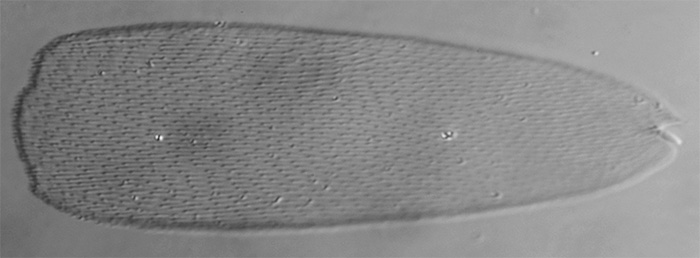
One of the few scales in the strew of the whole mount above that was close to the underside of coverslip and presented flat enough to allow some resolution. Zeiss 45X NA0.75 objective. DIC. Scale length 118 um.
Later, correctly labelled slides of the test species
The pair of slides left below show an example of a slide labelled with the correct genus of test species Lepidocyrtus and one with the full species name Lepidocyrtus curvicollis. The left hand slide is of the style of Watson but not labelled as such; this slide was studied in detail in the earlier article. The right hand slide is by Watson, the name and address form suggesting it was made after 1908 (12).
Richard Beck in 1862 was one of the first to mention the true attribution of the test species (21) and discussed potential reasons of the naming variation (29). Lubbock's definitive monograph of the springtails was published in 1873 (13), although a number of later articles published well into the 20th century continued to refer to the test subject species as 'Podura scales' without specifying the species studied.
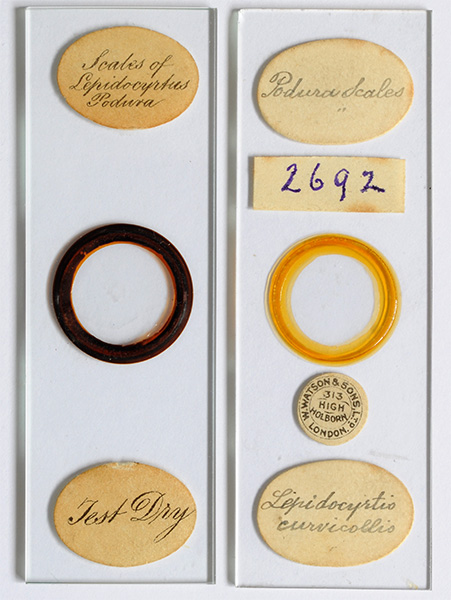
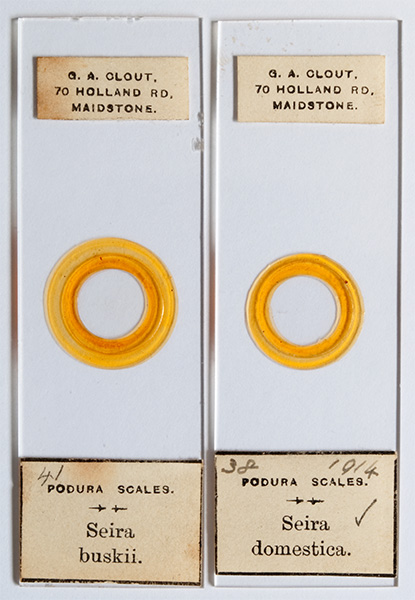
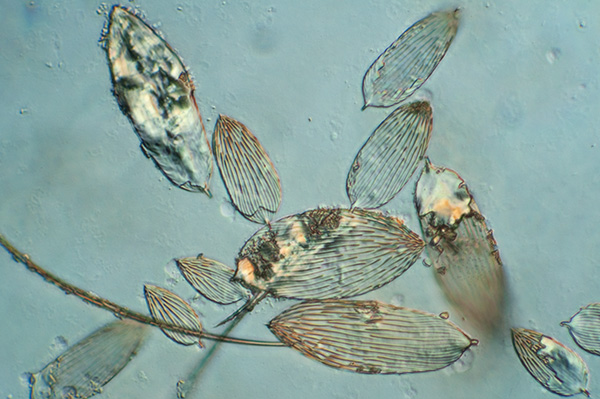
G A Clout slide, Seira buskii (now Willowsia buski, ref. 14). The scales are totally different from the test species L. curvicollis. The long thin club-shaped structures are likely macrochaeta. Larger scale length typically 78 um. Zeiss 40X NA0.75 objective, DIC.

G A Clout slide, Seira domestica. The scales have some resemblance to the test species L. curvicollis but the former has less demanding to study fine structure. Larger scale length typically 122 um. Zeiss 40X NA0.75 objective, DIC.
Two slides of other Podura species by G A Clout
The second pair of slides shown above are by G A Clout. This preparer has a brief entry in
the invaluable book by Bracegirdle (1) who notes that Clout 'mounted
Podura scales for
sale'
and is 'little-known' (2). Many preparers specialised in certain
subjects e.g. diatoms, but podura scales is an uncommon theme.
I would be
interested to hear from readers who have any slides by 'G A Clout' and
if any address label.
The two species shown are not widely reported as test scales, so may have featured as
part of a set for general interest. A Lepidocyrtus curvicollis slide
illustrated by Bracegirdle (2) is
the classic test species although not labelled as a test and has the same style of professional label. Both the examples possessed have extensive detritus either from the preparation or subsequent mountant deterioration.
Details of the mounter's microscopy
/ entomology background have proved elusive to
date. The 1911 census shows the
Clout family at the '70 Holland Road, Maidstone' address in Kent, UK.
The head of the family was Fanny Clout (née Strover) with six children
including
George Clout aged 24, occupation a joiner (3). Her husband Allchin
George
Clout died in 1911 aged 54 years (4) whose occupation was a builder's
foreman. In the 1891 census he was at the Holland Road address with his
family, occupation a bricklayer.
One of the slides above is dated
1914 and Bracegirdle remarks G A
Clout was working in 1915 (1). This rules out the Allchin George
Clout as
the active
preparer in this period. The 1901 census confirms that his son was
George Arthur
Clout i.e. the slide preparer, who would have been in his late twenties
at the time of the
dated slides.
George Arthur Clout was born at his
parent's home 51 Allen Road, Maidstone, Kent on April 15th 1886 (5 and
footnote 1). He marrried Edith Mary Holdaway
(a
spinster) in May 1915 in
Maidstone. They were both living at 2 Princes St at the time of
marriage
(6). They had at least two children, Joan Margaret Clout in 1920 and
Muriel A. in 1928 (3).
George died on Dec. 14th 1976 in Orpington, Kent (7 and footnote 2). A '226 Tonbridge
Road, Maidstone' address is also documented for his slide work (1).
It would be interesting to know
what prompted George Clout junior's specialism at a relatively early age including
contact with a Scottish university research fellow (see below) and
selling
professionally labelled slides (see footnote 3). The dated slides are
also at a period when he was getting
married and likely a busy time of life.
Google Books' powerful search
engine which includes text recognition of scanned images of printed
material, reveals that a 'G A Clout'
of Maidstone (1914) and later of Brasted, Sevenoaks (1933-76) was
mentioned in at least eight records in natural history publications
online. The full address given in some records is the same Brasted,
Sevenoaks address as on the slide preparer's death certificate (7) and
thus confirming that it is the same G A Clout.
Records (8) include: cited as a collector of isopods in
1914 by the author of a paper in the 'Scottish Naturalist' (9);
an active member
of SE England bee-keeping societies with a particular interest in bee
diseases; an
article by him on Acarine bee disease in an international journal (10);
cited as a rearer in 1933 of Sciaridae flies,
a less
studied group of small Diptera (11). These records
suggests an expertise in a number of less popular groups of entomology
and contacts with both professional and amateur workers both local and wider afield.
A browse through a variety of
microscopy and entomology publications of the period has not revealed
further information to date. I would be
interested to hear of any other microscopy / entomology references
known to a G A Clout of Kent ca. 1910 - 1976, sales adverts for slides
etc.
Comments to David Walker are welcomed.
Footnote 1: The census records
for 1891, 1901 and 1911 for George Arthur provided by his parents state
that he was born in 1887 in Maidstone. The date given by his mother on
his birth certificate is 1886. His death certificate, details provided
by his daughter Joan, states he was born on April 15th 1886 in Ulcombe,
Kent (a village ca. 7 miles SE of Maidstone).
Footnote 2: Allchin George Clout
died of a 'cerebral tumour and thrombosis' (4) at the National Hospital
in Queen Square, London which still exists and which specialises in
neurology. The present author is uncertain if National Insurance would
have covered this treatment some distance from his home town of if
personal means were also required.
Footnote 3: Thank you to Brian
Stevenson who notes that some mounters did have modest non-professional
backgrounds, for example, 'JT Norman ‘s original occupation was making
brushes'.
Acknowledgements:
Thank you to Frans Janssens, Dept. of Biology, University of Antwerp and
co-editor of the www.collembola.org website for his patience and time
in providing a valuable
insight into the complexities of springtail systematics from the 19th century to the present and also suggestions on this article. Any errors, including in the brief comments on taxonomy in the above article
are however solely the present author's.
Thank you to Brian Stevenson for helpful observations on G A Clout's working background.
Related Micscape articles: Exploring classic insect test
objects for the microscope: II - Scales of 'Podura' (springtail)
Update Feb. 2022. Brian Stevenson on his excellent microscopist.net site has added a more extensive biography of G A Clout with examples of his typical slides.
References and additional notes:
1) B Bracegirdle, 'Microscopical
Mounts and Mounters', Quekett Microscopical Club, London, 1998.
2) ibid, Plate 9 slide J and caption, pages
122-123.
2a) Ibid. 'SLIDES, SIZES OF' entry, p. 86. 2b) Ibid. Figure C, plate 54, p.212.
3) Census records via www.findmypast.co.uk.
4) Allchin George Clout, certified
copy of death certificate, General Register Office, UK. Entry - Holborn, 2nd quarter, vol. 1B,
p.317.
5) George Arthur Clout, certified
copy of birth certificate, General Register Office, UK. Entry -
Maidstone, 1886, 2nd quarter, vol. 2A, p.743.
6) George Arthur Clout and Edith
Mary Holdaway, certified copy of marriage certificate, General Register
Office, UK. Entry - Maidstone, 1915, 2nd quarter, vol. 2A, p.2323.
7) George Arthur Clout, certified
copy of death certificate, General Records Office, UK. Entry - Bromley,
1976, 4th quarter, vol. 11, p.1361. Address at death 'Tannery
Cottage, Rectory Lane, Brasted,Sevenoaks, Kent.' Occupation 'retired
joiner'.
8) See Google Books entries for 'G
A
Clout' search.
9) W
E Collinge, 'On the specific identity of the wood-louse, Oniscus fossor, Koch, 'Scottish Naturalist', 1916,
p.143. A 'Mr G. A. Clout, Maidstone (December, 1914)' cited as
collector.
10) G A Clout, 'Some notes on
Acarine bee disease', 1946, Bee World (a Journal of the International
Bee Research Association), vol. 27-29.
11) F Menzel, J E Smith, P J
Chandler, 'The sciarid fauna of the British Isles (Diptera: Sciaridae),
including descriptions of six new species', Zoological Journal of the
Linnean Society, 2006, 146, 1–147. Cited in the list of collectors as
'G. A. Clout' on p.6. Sevenoaks. Later cited on p.112 in 'Materials
Examined' entry of a species: 'Sevenoaks, Kent, 2 males, i.1933
(reared), Clout leg. (BMNH).
12) B Bracegirdle, 'Notes on Modern Microscope Manufacturers', 1998, Quekett Microscopical Club, 1995.
13) Sir John Lubbock, 'Monograph on the Collembola and Thysanura', 1873, London, Ray Society. Ref. 21a, p. 55. Beautifully scanned and free to download in various formats from www.archive.org.
13b) J Beck, 'Essay on the scales of the Collembola and Thysanura', Appendix to ref. 13.
14) Frans Janssens, co-editor of www.collembola.org, personal communications.
15) S P Hopkin, 'A Key to the Collembola (Springtails) of Britain and Ireland', Field Studies Council (UK) AIDGAP Series, 2007, p. 111.
16) A Fjelleberg, 'Identification Keys to Norwegian Collembola', 1980, (with January 1983 'Additions and corrections'), Norwegian Entomological Society.
17) E M Nelson, 'On the Podura Scale', J. Royal Microscopical Society, 1907, 393-404 and Plate X.
18) W H Wollaston, 'A description of a microscopic doublet', Philosophical Transactions, 1829, 12. Cited by Nelson in ref. 17.
19) T. Gill, 'XLV On the Microscope, sub-section 'On the Podura'', Gill's Technological Repository, 1828, Vol II, p. 261.
20) F Janssens and D Walker, 2011, (working copy in preparation, raising queries as they arise). Note on the identification of the 'Podura' of Victorian instrument makers.
21) R Beck, 'On the SCALES of LEPIDOCYRTUS ____? hitherto termed PODURA SCALES, and their value as TESTS, for the MICROSCOPE', Trans. Microscopical Soc, 1862, Vol. X, New Series, 83-88 and Plate X.